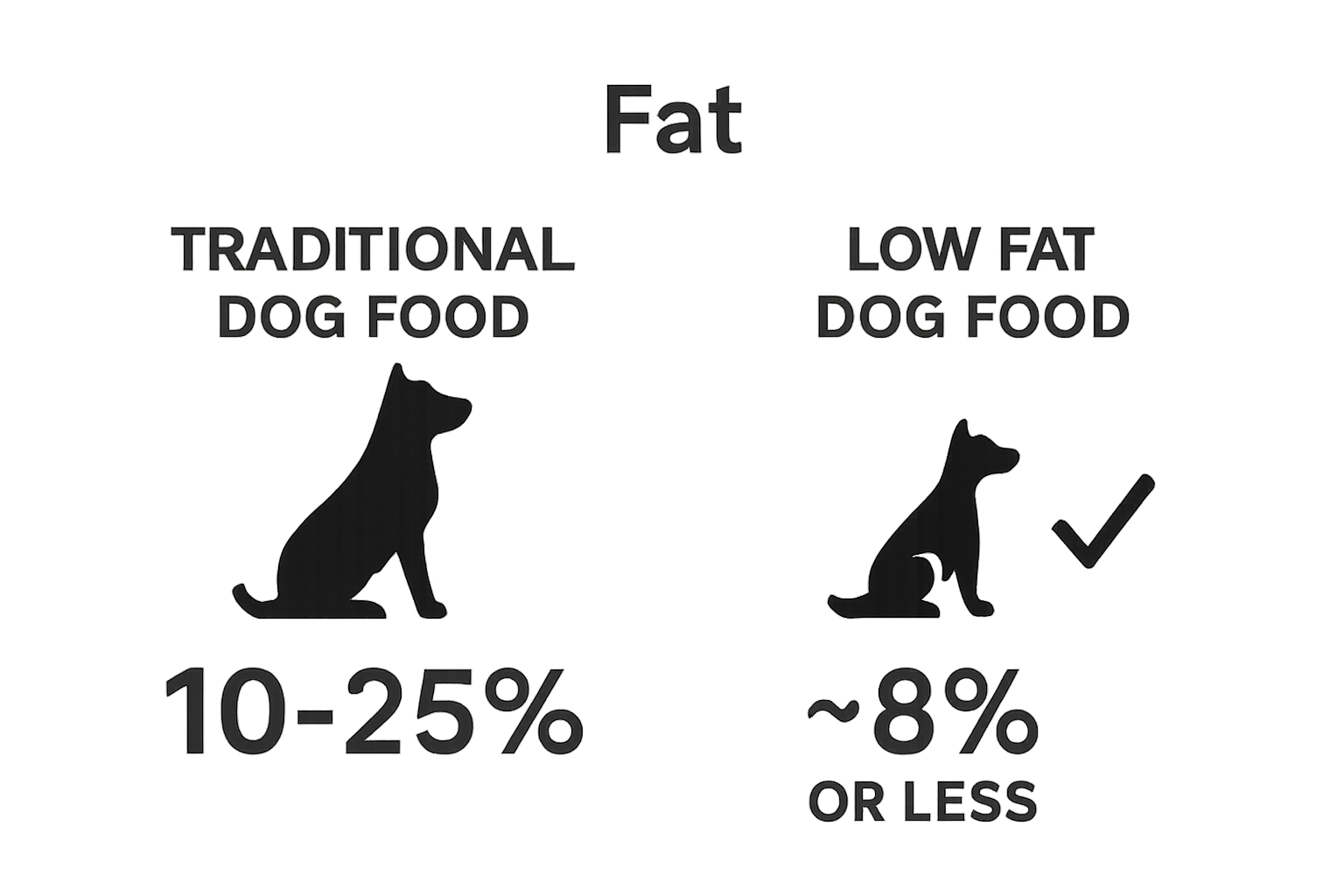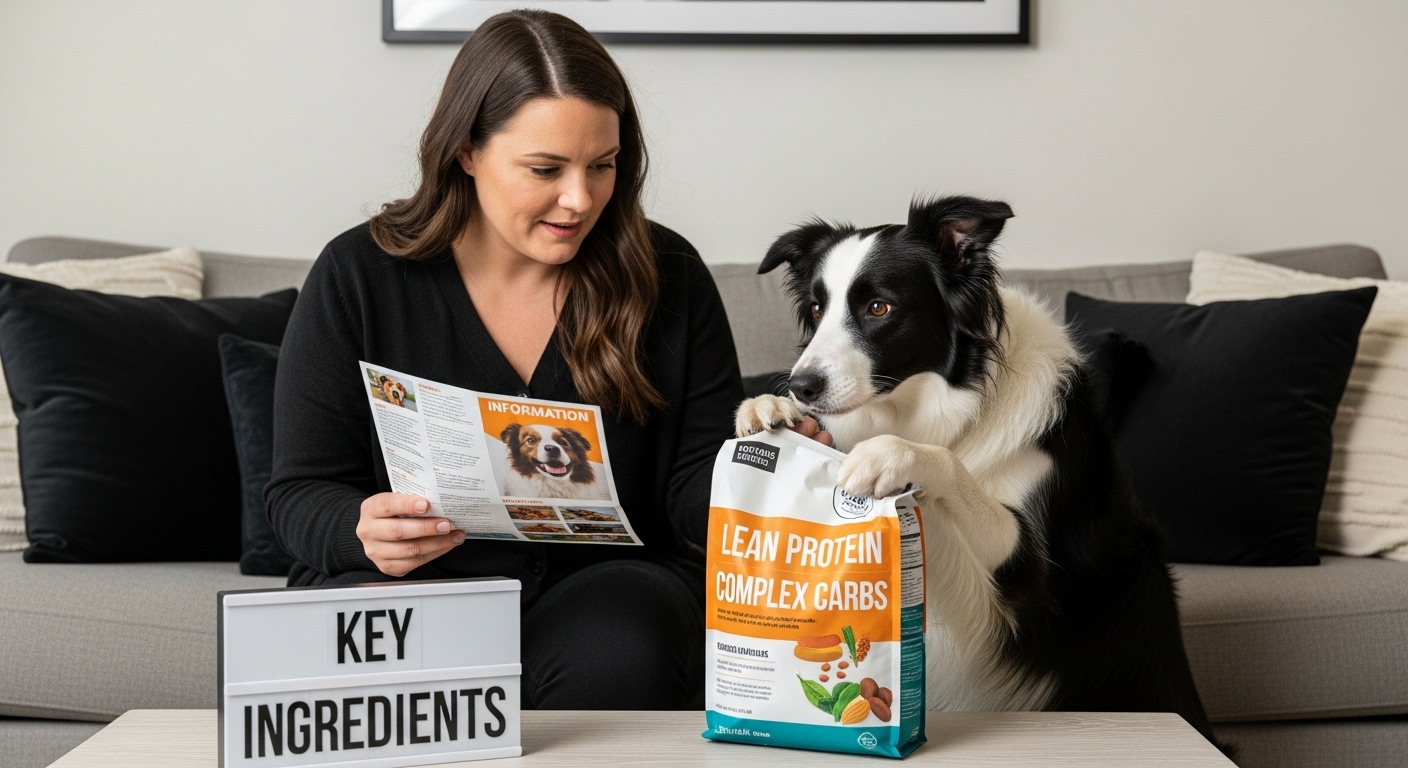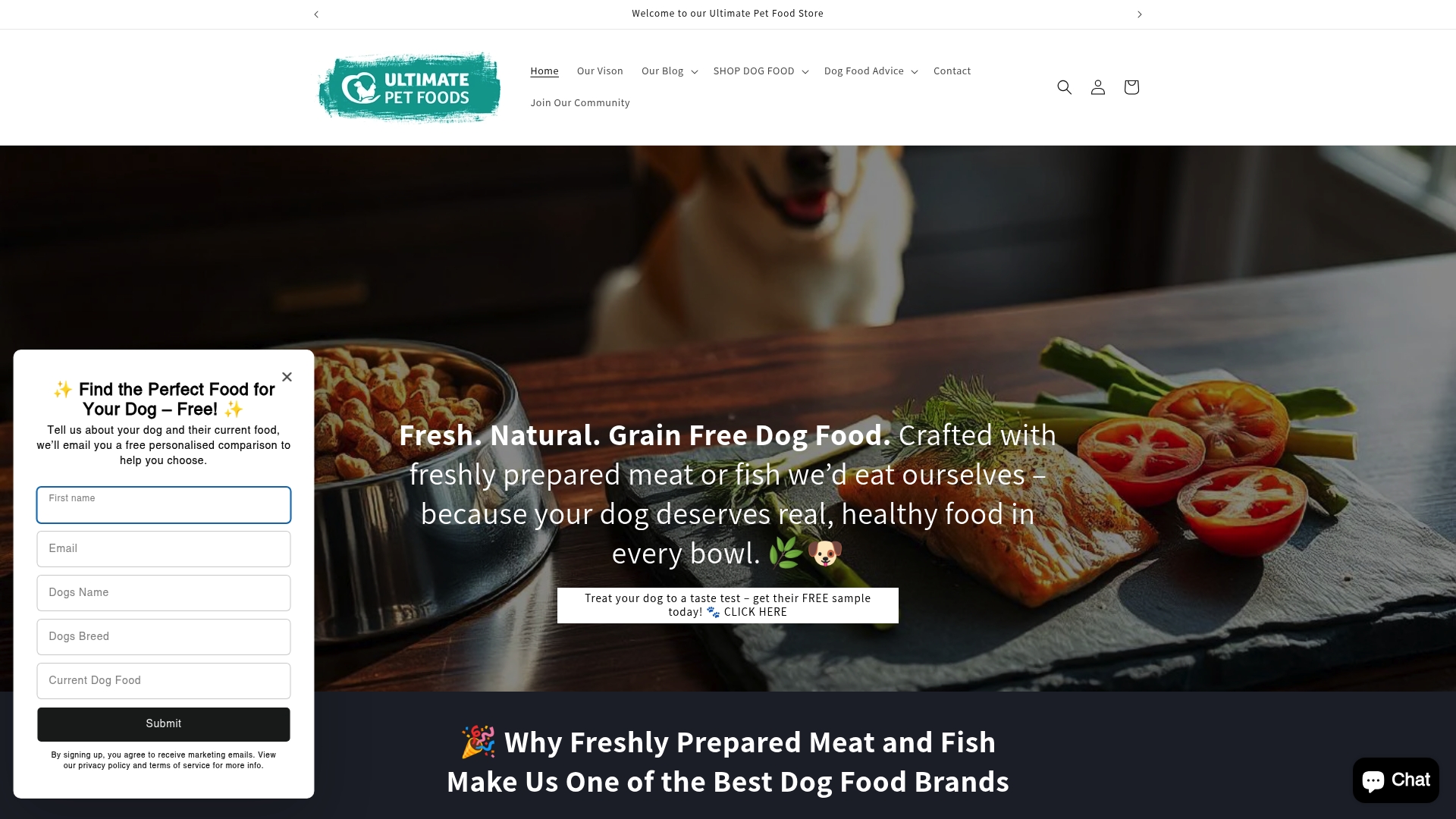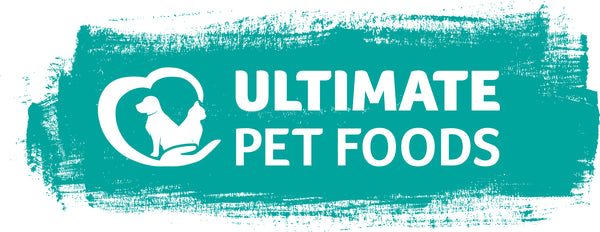
Understanding Low Fat Dog Food: Key Concepts and Insights
Share
Low fat dog food sounds like a strict menu for pups with dietary woes, right? Yet, most owners are stunned to learn that traditional dog foods can contain up to 25 percent fat, far more than many would ever expect. The twist is that low fat choices do not just cut calories. They are actually engineered to deliver targeted nutrition for pets with sensitive health needs and even help manage serious conditions like pancreatitis.
Table of Contents
- What Is Low Fat Dog Food And How Is It Made?
- Why Low Fat Dog Food Matters For Pet Health
- Key Ingredients In Low Fat Dog Food
- How Low Fat Dog Food Supports Specific Health Needs
- Understanding The Different Types Of Low Fat Dog Food
Quick Summary
| Takeaway | Explanation |
|---|---|
| Low fat dog food supports specific health needs. | These formulations promote wellness by aiding dogs with obesity, pancreatitis, or metabolic disorders. |
| Lean protein sources are essential. | White fish, chicken breast, and turkey provide necessary amino acids while keeping fat content low. |
| Careful ingredient selection is crucial. | Whole grains and vegetables ensure energy and nutrition without excess calories or fats. |
| Prebiotics enhance digestive health. | Ingredients like MOS and FOS improve gut balance, boosting nutrient absorption and overall metabolic wellness. |
| Understand different food types available. | Kibble and wet options both serve unique dietary needs, offering convenience and hydration respectively. |
What is Low Fat Dog Food and How is it Made?
Low fat dog food represents a specialised nutritional approach designed to support canine health by reducing overall fat content in their diet. This carefully formulated nutrition strategy targets dogs with specific health requirements, weight management challenges, or metabolic conditions that necessitate lower dietary fat intake.
Understanding Low Fat Nutritional Composition
Traditional dog foods typically contain between 10 to 25 percent fat content. Low fat dog food, by comparison, usually contains approximately 8 percent or less fat by weight.
 These formulations are meticulously developed to provide balanced nutrition while minimising fat intake, ensuring dogs receive essential nutrients without excessive caloric density.
These formulations are meticulously developed to provide balanced nutrition while minimising fat intake, ensuring dogs receive essential nutrients without excessive caloric density.
Our guide on understanding natural dog food ingredients offers deeper insights into how specialised diets are crafted to meet specific canine nutritional needs. The production process involves several key considerations:
- Selecting lean protein sources with minimal fat content
- Using gentle cooking techniques that preserve nutritional integrity
- Incorporating alternative nutrient sources to maintain energy levels
Production Techniques for Low Fat Dog Food
Manufacturing low fat dog food requires precise nutritional engineering. Producers typically use freshly prepared meats that are gentle cooked at 82 degrees Celsius to lock in nutrients and minimise fat retention. This process involves carefully selecting protein sources like white fish, chicken breast, and lean beef cuts that naturally contain lower fat percentages.
The gentle cooking method ensures that proteins remain bioavailable while reducing overall fat content. Prebiotic ingredients like MOS and FOS are often incorporated to support digestive health, creating a comprehensive nutritional profile that goes beyond simple fat reduction.
Dogs requiring low fat diets might include those with:
- Pancreatitis
- Obesity
- Specific metabolic disorders
- Sensitive digestive systems
By understanding the intricate balance of nutrition and fat content, pet owners can make informed decisions about their dog’s dietary needs, promoting optimal health and well-being.
Why Low Fat Dog Food Matters for Pet Health
Low fat dog food plays a critical role in maintaining optimal canine health, addressing numerous physiological challenges that can significantly impact a dog’s quality of life. Understanding the broader implications of dietary fat management helps pet owners make informed nutritional choices for their furry companions.
Health Risks of Excessive Dietary Fat
Excessive fat intake can lead to numerous health complications for dogs. Weight gain represents just the surface of potential issues. Metabolic disorders, increased inflammation, and compromised organ function are serious consequences of prolonged high fat consumption. Understand the common ingredients impacting dog health to make more informed dietary selections.
Key health risks associated with excessive dietary fat include:
- Increased risk of pancreatitis
- Higher probability of developing obesity
- Potential cardiovascular complications
- Reduced mobility and joint stress
- Compromised immune system functionality
Nutritional Balance and Metabolic Management
Low fat dog food provides a strategic approach to managing canine nutrition. By carefully controlling fat intake, these specialised diets support metabolic health while ensuring dogs receive essential nutrients. Protein quality, balanced micronutrients, and precise caloric density become paramount in these formulations.
Veterinary nutritionists emphasise that low fat diets are not about deprivation but about intelligent nutritional engineering. The goal is creating a diet that supports optimal physiological function while preventing potential health risks. Dogs with specific conditions such as chronic pancreatitis, liver disease, or those recovering from surgical procedures particularly benefit from these carefully constructed nutritional profiles.
The holistic approach of low fat dog food extends beyond simple weight management.
It represents a comprehensive strategy for supporting long term canine wellness, addressing individual metabolic needs, and promoting overall health through intelligent nutritional design.
Key Ingredients in Low Fat Dog Food
Low fat dog food is distinguished by its carefully selected ingredients that deliver optimal nutrition while maintaining minimal fat content. The strategic composition of these diets requires precise nutritional engineering to ensure dogs receive balanced, wholesome nutrition without excess calories.
Lean Protein Sources
Protein represents the cornerstone of low fat dog food formulations. Carefully selected lean protein sources provide essential amino acids and support muscle maintenance without contributing excessive fat. Explore ingredients to avoid for healthier nutrition to understand comprehensive canine dietary needs.
Optimal lean protein sources include:
- White fish (cod, haddock)
- Chicken breast
- Turkey
- Lean beef cuts
- Egg whites
Complex Carbohydrate Components
Complex carbohydrates play a crucial role in low fat dog food, providing sustained energy and essential dietary fibre. Whole grains and vegetable-based carbohydrates offer nutritional density without contributing significant fat content. These ingredients support digestive health, provide steady energy release, and help maintain stable blood sugar levels.
Key complex carbohydrate ingredients typically feature:
- Brown rice
- Quinoa
- Sweet potatoes
- Barley
- Pumpkin
Additionally, prebiotic ingredients like MOS and FOS are often incorporated to support digestive microbiome health. These specialised ingredients enhance nutrient absorption, boost immune function, and contribute to overall metabolic wellness without increasing dietary fat content.
By understanding and selecting high-quality, nutrient-dense ingredients, low fat dog food offers a comprehensive nutritional approach that supports canine health through intelligent dietary design.

How Low Fat Dog Food Supports Specific Health Needs
Low fat dog food emerges as a targeted nutritional solution addressing various canine health challenges. By carefully modulating dietary composition, these specialised formulations provide strategic support for dogs with specific metabolic, digestive, and physiological requirements.
Managing Metabolic Disorders
For dogs struggling with metabolic complications, low fat diets offer a critical intervention strategy. Precise nutritional engineering helps manage conditions like obesity, diabetes, and lipid metabolism disorders. Learn more about holistic dog nutrition approaches to comprehend the broader context of specialised dietary management.
Specific metabolic conditions benefiting from low fat diets include:
- Canine diabetes
- Hypothyroidism
- Cushing’s syndrome
- Metabolic syndrome
- Insulin resistance
Supporting Digestive Health
Dogs with compromised digestive systems find significant relief through low fat nutritional strategies. Reduced fat content minimises digestive strain, particularly for animals recovering from pancreatitis or experiencing chronic gastrointestinal inflammation. The carefully balanced nutritional profile supports optimal nutrient absorption while preventing additional metabolic stress.
Key digestive health considerations in low fat diets involve:
- Reduced pancreatic stress
- Enhanced nutrient bioavailability
- Improved gut microbiome balance
- Minimised inflammatory responses
- Consistent energy distribution
Prebiotic ingredients like MOS and FOS play a crucial role in these formulations, supporting microbiome health and enhancing overall digestive function. By providing easily digestible proteins, complex carbohydrates, and targeted nutritional support, low fat dog food represents a sophisticated approach to managing complex canine health challenges through intelligent dietary design.
To help clarify which dogs benefit most from low fat dog food and how these formulations support specific health challenges, the table below categorises key conditions and the corresponding dietary mechanisms involved.
| Health Condition | How Low Fat Dog Food Helps | Key Dietary Features |
|---|---|---|
| Pancreatitis | Reduces pancreatic workload and inflammation | Very low fat, highly digestible proteins |
| Obesity | Lowers caloric intake, aids weight management | Controlled fat, lean proteins, fibre rich |
| Diabetes | Helps manage blood sugar and weight | Moderate carbohydrate, low fat, high protein |
| Metabolic Disorders | Supports balanced metabolism | Tailored macros, enhanced digestibility |
| Sensitive Digestion | Minimises gastrointestinal stress | Gentle ingredients, prebiotics, low fat |
Understanding the Different Types of Low Fat Dog Food
Low fat dog food is not a monolithic category but a nuanced range of nutritional solutions tailored to diverse canine health requirements. Understanding the various types enables pet owners to make precise dietary choices that align with their dog’s specific metabolic needs and health conditions.
Kibble Based Low Fat Formulations
Dry kibble represents the most common low fat dog food format, offering convenience and consistent nutritional profiles. Learn how to read dog food ingredients effectively to make informed nutritional decisions. These formulations typically contain approximately 8 percent or less fat content, carefully engineered to provide balanced nutrition without excess calories.
Key characteristics of low fat kibble include:
- Precise fat percentage control
- Extended shelf life
- Convenient storage and portioning
- Consistent nutritional density
- Easy digestibility
Specialised Wet Food Low Fat Options
Wet low fat dog food provides alternative nutritional strategies for dogs with specific dietary requirements. These formulations often feature higher moisture content, which can be beneficial for dogs requiring additional hydration or experiencing reduced appetite. Wet food low fat options typically incorporate lean protein sources like white fish, chicken breast, and carefully selected proteins that minimise fat content.
Unique aspects of wet low fat dog food include:
- Enhanced palatability
- Higher moisture content
- More diverse protein sources
- Softer texture for senior or dental challenged dogs
- Potential increased nutrient bioavailability
By understanding these diverse low fat dog food types, pet owners can make sophisticated nutritional choices that support their dog’s unique health profile. The key lies in recognising individual metabolic needs and selecting appropriately engineered dietary solutions that promote optimal canine wellness.
The following table compares dry kibble and wet food low fat dog food formulations, aiding pet owners in deciding which format aligns best with their dog’s dietary preferences and health requirements.
| Feature/Characteristic | Low Fat Kibble | Low Fat Wet Food |
|---|---|---|
| Typical Fat Content | ~8% or less | ~8% or less |
| Storage & Shelf Life | Long, easy to store | Shorter, requires refrigeration |
| Moisture Content | Low | High |
| Palatability | Moderate | Enhanced |
| Suitability for Seniors | Good, may be hard if dental issues | Excellent, soft texture |
| Key Protein Sources | Dried and fresh lean meats | Fresh, diverse lean meats |
| Digestibility | Consistent, easy to portion | Highly digestible |
Take Control of Your Dog’s Health with Science-Backed Low Fat Nutrition
Recognising the risks of excess fat in your dog’s diet can be overwhelming. Concerns about pancreatitis, weight gain, and sensitive digestion are often at the forefront when choosing the right food. The article highlighted the science behind low fat dog food, focusing on metabolic management, lean proteins, and the importance of nutritional balance. You want confidence that every meal supports your dog’s wellness, with carefully chosen ingredients and proven health benefits.
Explore our Grain-Free Dry Dog Food collection for expertly formulated, low fat options designed to support weight management and sensitive stomachs.

Give your dog access to trusted, freshly prepared, natural recipes that make a real difference in everyday wellbeing. Discover a complete range of science-backed meals for every breed and life stage by visiting Ultimate Pet Foods now. Gift your dog the foundation for a healthier, happier life—start making positive changes today.
Frequently Asked Questions
What exactly is low fat dog food?
Low fat dog food is a specially formulated diet designed to reduce the overall fat content to approximately 8 percent or less. It’s primarily aimed at dogs with specific health needs, such as weight management or metabolic disorders.
How is low fat dog food made?
Low fat dog food is made using lean protein sources and gentle cooking methods to preserve nutrients while minimising fat. Ingredients are selected to ensure balanced nutrition without excessive caloric density.
What are the health benefits of feeding my dog low fat dog food?
Feeding low fat dog food can help prevent health issues related to excessive dietary fat, such as pancreatitis, obesity, and compromised organ function. It supports metabolic health and can be beneficial for dogs with specific conditions.
What types of low fat dog food are available?
Low fat dog food is available in various forms, including dry kibble and wet food options. Kibble offers convenience and consistency, while wet food can provide additional moisture and palatability, catering to dogs with specific dietary needs.
Recommended
- What Ingredients to Avoid in Dog Food for Healthier Pups – Ultimate Pet Foods
- Understanding Dog Foods to Avoid for Optimal Health – Ultimate Pet Foods
- How to Read Dog Food Ingredients: Make Informed Choices – Ultimate Pet Foods
- Understanding Common Dog Food Ingredients for Healthier Pups – Ultimate Pet Foods
- Understanding Healthy Fats Examples for Better Health - LeanAndFit
